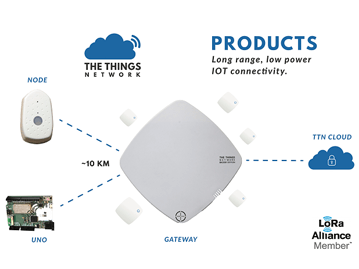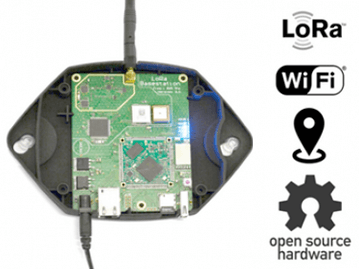The Things Network – An Interview with Wienke Giezeman on IoT Business
The Things Network creates a public, crowd-sourced Internet of Things network owned and operated by the users, allowing IoT devices to connect and communicate without the need for 3G or WiFi.
After achieving global recognition and successfully building a data network that covered the entirety of their home city of Amsterdam, The Things Network recently announced a partnership with Premier Farnell for the manufacture, marketing and distribution of their products. We spoke to co-founder Wienke Giezeman to find out more...

The Things Network allows users to contribute by placing new gateways to expand network coverage.
In a nutshell, what is The Things Network?
The Things Network is a crowd sourced initiative that uses LoRaWAN radio frequency sensors and gateways to build open transmission networks for IoT. In practice, users set up gateways and connect them to share data connectivity without the need for 3G or WiFi.
Tell us about the technology you used in the project...
The technology we currently support is LoRaWAN, which is capable of connecting thousands of devices within a range of around 10 kilometres, with a low bandwidth that allows the batteries to last for up to 3-5 years. We’re also in the process of updating our servers so that they can support Bluetooth; we already have a Bluetooth chip built into our gateway devices for this purpose.
In addition to the Gateway, we also offer an Arduino board with a LoRaWAN chip that allows it to connect to The Things Network, and a development device that already has some sensors on board and needs almost no configuration.
Where did the idea for The Things Network originate?
In 2015, along with my co-founder Johan Stokking, we came up with the idea to build a LoRaWAN network for the city of Amsterdam. We realised we could offer coverage for the entire city with as few as ten LoRaWAN gateways, which could be a major breakthrough for IoT devices that need to run on battery for a long time while sending small amounts of data. Relying on WiFi and 3G for this connectivity can drain a device’s energy quickly, and also prove quite costly.
Our vision was that the businesses and makers who would be interested in making use of this network would also be the ones who built and invested in it, rather than relying on major providers. In other words, we wanted to create an open data transmission network that was truly owned by the users.
After we launched the project in Amsterdam, the concept quickly went viral across the global IoT community. One year later, we have communities in 300 cities across 70 countries. We’re now preparing to ship the devices we’ve sold through our Kickstarter campaign , meaning we’ll have around 2,000 active gateways around the world.
Why did you decide to go down the crowd-sourcing route?
Crowd sourcing for us is very much a means to an end. We see it as a tool for reaching our goal of creating an open, decentralised network that allows anybody to start innovating and developing without depending on a large organisation. Having already achieved so much interest within the IoT community, we felt that a Kickstarter campaign was the logical next step to pre-fund our production.
Why do you think The Things Network captured people’s imaginations to such an extent even before you launched the Kickstarter?
There are so many IoT and prototyping devices on the maker scene at the moment, but most of the time the image connected to them is that of an Arduino device or similar connected to a computer via a USB cable. I think there was a lot of demand for a practical and affordable way for users to disconnect their IoT products from the computer and make them more long range.
Also, our network allows you to build your prototype without relying on any provider or network operator. You can simply build a network yourself at a fairly low cost. This level of enablement is really appealing to a lot of people. It’s a bottom-up, rather than a top-down approach. Anyone can do it, providing they have the right tools.
How did Premier Farnell become involved with the project?
We were introduced to Premier Farnell through Microchip, who had been a partner from very early in the project. We’d seen how well Premier Farnell and element14 had worked together with Raspberry Pi , and we were confident that they really understood the importance of community and social incentives.

The Things Gateway uses a long range and low-power radio frequency protocol called LoRaWAN, plus Bluetooth 4.2 for short range, allowing IoT devices to talk to the internet without 3G or WiFi.
What does working with Premier Farnell mean for The Things Network?
Working with Premier Farnell means we’ll be able to offer general availability of our product at a global level. It also puts in touch with a large maker audience looking to develop their IoT products at a low cost. There are already over 425,000 members on the element14 community, using devices such as Arduino and Raspberry Pi to power their creative projects. There’s a huge opportunity there for them to leverage our long-range wireless connection technology to enhance those projects and reduce their overheads.
What are the biggest challenges you’ve faced so far in The Things Network project?
The main challenge has been the logistics of bringing a product like this to market while mitigating the financial risks. When you’ve already attracted investment via Kickstarter, there’s a degree of pressure to get the components ready on time, but you also don’t want to order those components until you have a finalised design, etc.
Partnering with larger organisations that have the power and experience to help us with aspects such as design optimisation and distribution has been a major factor in our success so far. Getting Microchip and Premier Farnell on board has felt like standing on the shoulders of giants.
Where do you see The Things Network 12 months from now?
Twelve months from now I’d like to see our gateways providing coverage in major cities all over the world. We’ll see more professional organisations contributing to the community by running network services and generating true value.
We’ll also be seeing a lot more interesting applications that use our network gateways. For example, I’d like to see an app that tells me when my local garbage containers are full, so that I don’t have to walk down to check on them. I’d like to see cities using IoT applications to be more responsible in their power consumption, and to start exploring what kinds of power consumption they’re actually relying on.

Featuring movement, light and temperature sensors plus an RGB light and a button, The Things Node is a versatile device for testing or building plug ‘n’ play IoT features.
What about 3-5 years from now?
In the longer term, I think we’re going to see much wider use of frequency technology, and I’m hopeful that we’ll be able to provide even cheaper gateways. Data connectivity should one day be as easily available as water out of a tap.
What are the security considerations of using The Things Network?
I think it’s important to make the distinction that what we provide is not so much an open data network as an open transmission network. At the moment, our gateways work by connecting two data platforms, meaning that your data has an intermediate encryption. You also have the option to run the cloud services yourself if you want to ensure you have a truly end-to-end encrypted solution.
If public data networks are truly adopted in a broad way, do they have the potential to force out private networks?
No, I think the two services are more likely to be complimentary, I don’t see it as a competition. Larger operator networks might offer a cost-efficient solution for the enterprise market, but there’s always a need for local solutions run by local people that want to keep security and control high while also keeping their costs low.
What have been some of your most rewarding moments to date?
Seeing the success of the Kickstarter was a very rewarding moment, obviously. But I derive the most joy from the moments when people confront me with ideas they’re building using the Things Network that I would never have thought of. Every so often, somebody will come up with a solution to a problem that really surprises you.
Who are your professional heroes in the industry?
Dirk Alhorn, the CEO of HYPERLOOP would be one, and of course Elon Musk. They way they approach open and collaborative innovation is really inspiring, and it’s exactly what we embrace with our communities. Everything is open source, the network is open and everybody shares knowledge. If you look at how, for example, HYPERLOOP is built, it’s a completely collaborative organisation. We want to be able to emulate that.
What other start-ups or emerging technologies are you excited about at the moment?
I like everything that’s open, and anything to do with the fourth industrial revolution. So if you’re talking about AI, robotics, big data and solar power – those are all things that are really interesting to me. What’s exciting is that I believe what we’re doing could be the glue that connects all of these areas together.
What technologies or innovations would you like to see in the IoT space that aren’t currently available?
I’d like to see even more innovation in energy harvesting and energy efficient technology. Right now, if you place a sensor somewhere, you don’t want to have to charge it every day, you want to be able to leave them to do their job, which is harvesting data. Right now, there are sensors that can last for up to 3-5 years, but a completely autonomous sensor that doesn’t rely on an external power source of any kind is sort of the holy grail of IoT technology.
Finally, what advice would you give to somebody who is in the early stages of an IoT project and might be looking for opportunities to develop it and take it to the market?
Focus on the data, focus on the problem you’re trying to solve, and start small. Your first technology push should be towards something you can do cheaply and on a small scale, then you can start talking to customers about the different ways in which you can apply it. Don’t invest too much too soon. When you have the fundamentals in place, you can easily scale up. That’s exactly how we built our platform and developed our products.
For more information about Premier Farnell’s partnership with The Things Network, read our case study here.
You can also register your interest in pre-ordering The Things Network hardware here.